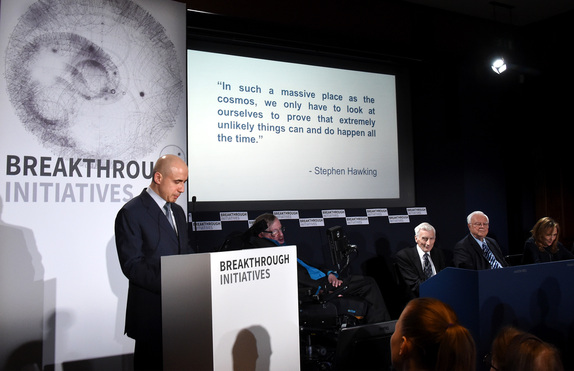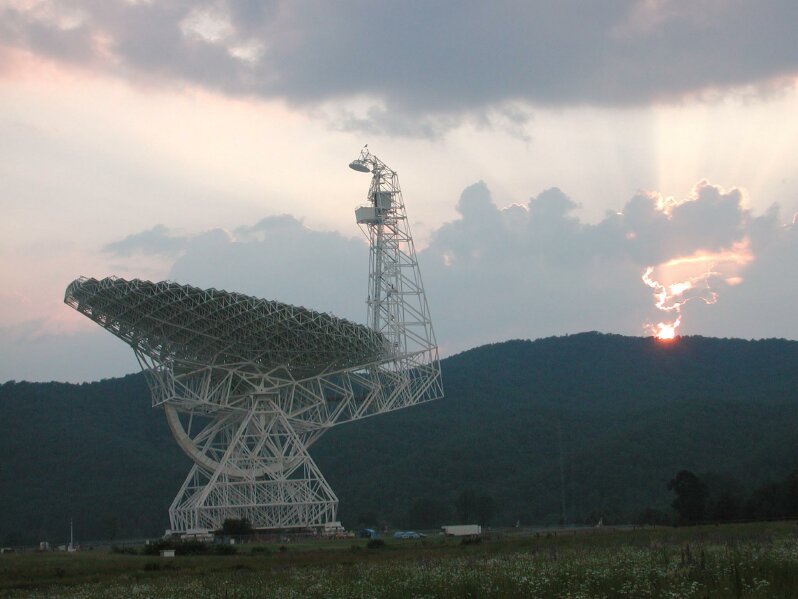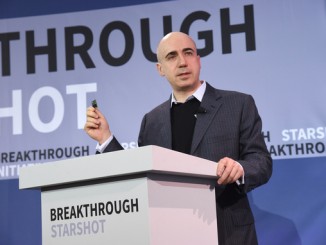
Russian entrepreneur Yuri Milner is pledging $100 million to fund the most sophisticated search for extraterrestrials ever attempted, a 10-year campaign using radio and optical telescopes, ultra-sensitive detectors and state-of-the-art software to study nearby stars and galaxies for tell-tale signals of alien civilizations, he said Monday.
Joined by Frank Drake, the U.S. astrophysicist who pioneered the search for extraterrestrial intelligence, or SETI, famed U.S. planet hunter Geoff Marcy, Astronomer Royal Martin Rees and other luminaries, including physicist Stephen Hawking, Milner said he was inspired to act by the recent discovery that Earth-like planets are commonplace.
Citing NASA’s Kepler spacecraft, which has detected hundreds of extra-solar planets and, by statistical extension, vast numbers of Earth-like worlds across the Milky Way, Milner said “that really opened up the conversation around intelligent life, providing us evidence that there are many billions of Earth-like planets in our galaxy alone.”
Milner announced two programs Monday in London. The “Breakthrough Listen” initiative will focus on the search for optical and radio signals from other civilizations while a “Breakthrough Message” competition will seek suitable responses to a signal if one is detected.
The latter will feature a pool of prizes totaling $1 million, although officials say there is no commitment to actually send such a message.
“It’s a way to learn about the potential languages of interstellar communication and to spur global discussion on the ethical and philosophical issues surrounding communication with intelligent life beyond Earth,” Milner’s organization said in a statement.
Ann Druyan, who worked with her husband, the late astronomer Carl Sagan, to develop a message from Earth carried on NASA’s twin Voyager spacecraft, said “we will succeed on this leg of the initiative if we inspire a new degree of self awareness and a sense of consciousness about what it is to be alive on this planet.”
“In formulating such a message, whether it be sent or not, you’re forced to really look at who you are, who you share this planet with,” she said. “And I think that will be all to the good. I know that these efforts ignite fascination in the young, and this is part of what we have to be doing as a civilization.”
The “Breakthrough Listen” program will survey the one million closest stars to Earth, across the plane of the Milky Way and toward its center where stars are densely packed and even other nearby galaxies.

The program’s instruments and detectors will be sensitive enough to discern emissions from Earth-level technologies, like air defense radars, some 2,000 light years away.
“The problem, I guess, (is that) they only illuminate a small fraction of the sky,” said Andrew Siemion, director of the SETI Research Center at the University of California at Berkeley. “So those radars would have to be pointed in our direction (to be detected).
“But of course, there are many, many stars along the line of sight towards the galactic plane or the galactic center, so we would have a very good chance of detecting those if we were pointed in that direction,” he said.’
Providing much-needed outside funding, the Breakthrough Listen project will buy extensive observing time on the football field-size National Radio Astronomy Observatory dish in Green Bank, West Virginia, and the 210-foot Parkes Observatory radio telescope in Australia. The project will cover 10 times more of the sky, with 50 times the sensitivity, of previous searches.
Equally important, Breakthrough Listen has arranged to use the 2.4-meter Automated Planet Finder Telescope at Lick Observatory in California to search for optical laser signals.
Marcy said “it’s possible, if the Milky Way galaxy actually has other intelligent species that are sending their spacecraft around the galaxy, maybe setting up colonies on other planets or even around other stars, they may be communicating with all of those sites using lasers.”
“Indeed, there could, therefore, be a sort of galactic internet … carried by laser beams crisscrossing the galaxy. And we here on the Earth may serendipitously just happen to fall in one of those laser beams. Moreover, it’s possible they know about us and they’re purposely shining their laser beams at us.”
The Breakthrough Listen project will take “spectra of thousands of stars and hundreds of galaxies looking for specific wavelengths, single wavelengths, at which there’s a lot of light that would be best interpreted as from lasers from some other civilization,” he said.
The data collected will be available to the public and Breakthrough Listen will join and support the SETI@home project, the University of California at Berkeley’s innovative screen saver program that uses idle personal computers to sift through collected data in search of unusual signals.
Project officials said any signal detection of possible extra-terrestrial origin would be treated like any other scientific discovery, requiring independent verification and peer-reviewed analysis. But they emphasized the program will be conducted “in the open” and that the public would be informed about any potential detections.
“I think it’s inevitable that there would also be a social dissemination of this information,” Siemion said. “And that’s something that would be very difficult for us to control. But I’ll reiterate again, a commitment to openness here to everything that we’re doing.”
“Our intention would certainly not to be to get folks excited about something that might turn out to be interference,” he said. “But by the same token, we’ll be absolutely open about any discoveries that we make and our level of confidence in them.”


